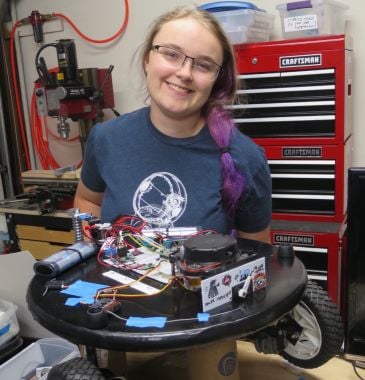In the May issue of Viking, we talked with Nancy Lorraine Jensen Memorial Scholarship recipient Shiloh Curtis. She hails from Sunnyvale, Calif., and attends college at MIT. Curtis is passionate about robotics. See more from the interview below.
Q: What sparked your interest in robotics?
A: I think my dad was mostly responsible for this. When I was a kid, we spent a lot of time building stuff together, or taking apart broken electronics. Eventually, I begged him to take me along to a monthly robotics meetup he attended. I had a great time building small, simple robots with him (mostly from kits) and showing them off at the meetup! I also learned a lot from the other attendees, which was immensely helpful when I started building more advanced robots.
Q: What types of devices are you creating for the visually impaired? What motivates you to create these? And when might some of them be released?
A: The H-NAV, my hat-based navigational aid, is the only device I’ve created for the visually impaired. It uses a LiDAR (the same type of sensor used on self-driving cars) to sense obstacles at approximately head height; vibrating motors in the hatband indicate these obstacles’ position to the user. My intent was for the H-NAV to be a useful aid complementary to, but not replacing, a white cane or other ground-level obstacle detector. Although I wish I had more time to devote to getting the H-NAV on the market, at the moment there are no plans for its release. At last year’s AT Hack, an assistive technology hackathon, my team worked on an app to help users with sensory sensitivities plan walking paths while avoiding areas likely to cause an overwhelming amount of sensory input. For example, an autistic user sensitive to loud noises could plan a route that avoids loud locations; this could help increase users’ personal autonomy and reduce the risk of going into meltdown at an inconvenient time. I’ve been trying to make plans to work on this app some more with members of my team, but so far the realities of MIT life have made it difficult to make enough time.
Q: How has your Sons of Norway scholarship helped you to pursue this passion?
A: My Sons of Norway scholarship has helped me to study robotics at MIT, which is how I’m learning what I’ll need to know to design household robots and assistive devices using new robotics technologies. Robotics problems are in many ways very like assistive-tech problems: We want both robots and disabled people to be more autonomous and better able to interact with a world designed for neurotypical, able-bodied humans. Thus, by studying robotics, I’m better prepared to design assistive tech as well.
Q: Do you have any ideas of what you might like to do after graduation?
A: My current general plan is to go to grad school and get a Ph.D. in robotics, then start working in the industry. I plan to spend my next two years at MIT preparing for the grad school admissions process, by doing more UROPs (undergraduate research opportunities) with robotics labs and by taking advanced classes in robotics.
Q: Any big plans for summer vacation?
A: I’ll be interning at Iron Ox! It’s a startup that uses robots for indoor produce farming in San Carlos, Calif.

